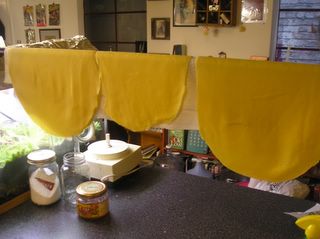At various protest events, there are groups of kids who dress in all black clothing, wear bandanas over their face, run from street to street, proclaim the joys of anarchy, and generally annoy the police. These kids call themselves the Black Bloc. I
*heart* the Black Bloc. In the FiDi (Financial District), there are another group of black bloc'ers, only these are seemingly pacified women and men trudging on their way to various office jobs. What is with office workers wearing all black all of the time? Is it more sophisticated than green? Funkier than beige? I can only assume it's a) they are in constant mourning due to hating their crappy jobs and/or b) they are really anarchists. And what's with the term "blue collar"? Last time I checked, half of the white collar professionals in the FiDi wore blue shirts, while the doormen, limo drivers, and Corovan movers all wore white. Perhaps it's time to re-evalute our terminologies.
Meanwhile, when I'm not contemplating the burning non-issues of the day...
Lately, I've been seeing whole chickens for sale at Safeway that are obscenely underpriced, mostly because their expiration date is drawing near. We're talking about 5 pound chickens for under $3. When chicken is that cheap, it just makes sense to buy one for stock. Having fresh, real chicken stock in the freezer is great, and it really improves the recipes you use it in.
That's how I began my day Saturday. Making the stock is really easy, and it makes the house smell great (though it drives the cats crazy). It does take 5 hours, but most of that time is spent letting it simmer unattended.
Basic Chicken StockTo make the stock, take a 4-5 pound chicken and cut it into pieces. Place the chicken in a large stock pot and cover with water until the chicken is just submerged. Bring to a simmer (usually by cranking the heat, then lowering it before it really starts to boil). Simmer for 3 hours, skimming the gunk off the top with a mesh strainer. After 3 hours, add an onion, largely diced, 3 bay leaves, and 2 teaspoons of salt. Simmer another 2 hours, then pour through a strainer to separate the meat/bones from the stock. Next, the part I hate…degreasing. You can try whatever method you do best. You can use a fat separator (mine cracked), or you can pour it all into a container, stick it in the fridge, and let the fat rise to the top and congeal, which when cool, is easier to separate. That's what I did. Afterwards, in a hot water bath, I brought the gelatinous stock back to a liquid state and divided it into plastic containers, measuring about 1½ cups, then stuck them in the freezer.

Le Stock
Although I was planning on making the stock anyway, I ended up using some of it in a variation of a dish I found in one of our cookbooks. The recipe is for Cream of Watercress soup, which I modified to be Cream of Nasturtium soup. Nasturtiums are members of the cress family of greens and have that bold, peppery flavor that watercress has. Since they grow wild around here and since we've had so much rain and sunshine, I figured I would experiment and try to use them in a soup. Early in the day, I went to my nasturtium location and began picking the tender leaves. Unfortunately, with the way nature works, there were no flowers (as of yet), which would've made a great garnish for the soup.

Washed Nasturtiums
I noticed that when picking the leaves, size doesn't matter. What matters is how tough they are and whether they're beginning to yellow around the edges. Also, my location is inaccessible to dogs and far from traffic, so I wasn't worried about toxins. Filling a plastic Safeway bag yielded half a pound. While I was there, I also picked some tender fronds of the wild fennel plants growing nearby. These I'm going to use in a chicken salad using, you guessed it, chicken used to make the stock.

My hands are guided by the spirit of Serge Gainsbourg
Crème De NasturtiumAdapted from French Regional Cooking by Anne Willan½ pound of nasturtium, washed
6 tablespoons butter
1 medium potato, peeled and sliced thinly
1½ cups chicken broth
salt & pepper to taste
1½ cups milk
¼ cup heavy cream
pinch of grated nutmeg
1. In a large pot of boiling water, blanch the nasturtiums for a couple of minutes. Then drain into a large colander and run them under cold water. Squeeze them dry and set aside.
2. On low heat in heavy saucepan, melt 2 tablespoons of butter and sauté nasturtiums for 2-3 minutes.
3. Add the sliced potato, broth, and salt and pepper and bring to boil. Cover and simmer, stirring occasionally, for 15-20 minutes or until the potatoes have softened.
4. Pour the soup into a food processor and puree. Then run it through a fine mesh strainer or work through vegetable mill to further refine the soup.
5. Return to the soup to the saucepan and add the milk; reheat. Add the heavy cream and bring just to a boil. Season with additional salt and pepper (to taste) and nutmeg.
6. Remove the saucepan from the heat and stir in the remaining butter. Garnish with flowers, nasturtium leaves, or a little dab of cream and serve hot.
This soup isn't like any I've tasted before. It really has a wild, grassy, field greens taste to it that could've been great with a fruity white wine. This soup was a first for Bruce and I and it's made me confident about using other wild greens in recipes.

Creme de Nasturtium
On Sunday we took a trip to Mount Diablo and the surrounding area. Wow! What a perfect time to be there. The weather was great and the wildflowers were in full bloom. Everything was so green and lush. Granted, I expected lakes of fire and tortured souls, since Mount Diablo means Mount Devil, yet any indication of the Great Horned One was nowhere to be found. I had never been to Mt. Diablo until Sunday and what a surprise. There is still so much open space, with rolling green hills sprinkled with California Oak Trees and native plants. On our trip I had three goals: one was to just enjoy being away from the city and to be out in "nature". The other two were lying in the grass (it's funny how you miss the small things), and trying to identify edible plants, though, not necessarily at the same time.
The drive up to the summit is along a narrow, two way road that doesn't have side barriers to prevent you and your little family from plummeting over the side in a fiery ball of death, and because of this, I had to look away a few times and pray that we wouldn't fall off. There are, however, breathtaking views of the delta to the north and of the hills looking to the south.

Mt. Diablo
There are many areas to pull to the side and step out of your car for the mandatory goofy picture, as well as picnic areas that are pretty well kept and which have trails that jet off into some interesting areas. We brought along some snacks and found a secluded spot in a picnic area called Rock City. Contrary to the title, this Cit-ay wasn't a series of vendor tents at Ozzfest, but an area dotted with large boulders jettisoning out of the hillside. I can imagine the stunned faces of many a mullet-headed, raging-hormonal, adolescent at this discovery. "Awww, Mom! Why did you lie to me, again?! Dude, nature sucks." At Elephant Rock, which looked more like, well, a rock, we dined on salt-cured black olives, slices of Gruyere, apples (Granny Smith and Braeburn), sourdough bread, and iced tea. To our disgust were some beer bottles, a 2-liter bottle of 7-Up, and a Cheetoz bag some brain-dead fools had discarded less than 100 feet from the nearest trashcan.
There is a special place in hell for these morons, and it looks nothing like Mt. Diablo.Mt. Diablo State Park has a wonderful diversity of plants and wildlife; actually I seem to remember foolishly wishing to see a rattlesnake or mountain lion. That's what I love about California, the abundance of fanged, poisonous, killer creatures (we did see a black widow!! Yay!). Of course, there are also an abundance of poisonous plants, so I don't recommend picking and eating willy nilly, even though I did bite into a California poppy flower to see if it was an appropriate salad ingredient. The answer is a resounding No; way too bitter. Growing in many areas next to the bright orange poppies was sagebrush, which has a bold, cool sage aroma that I immediately rubbed my hands with. Sagebrush grows abundantly around the area and I imagine it can be used in a variety of culinary and household ways.

Sagebrush and Poppy
Miner's lettuce was growing most abundantly in shaded, moist areas where the leaves grew large and dark green. The taste is relatively mild and somewhat resembles spinach. Of course, California bay trees were everywhere and their fresh leaves have a terrific aroma. Bruce says his family use to take bay branches and throw them on the grill, which would infuse whatever they were cooking with an intense bay flavor. The leaves can also be dried and used just like you would regular bay leaves. Buckeyes were also abundant as well as acorns. Both of these are poisonous eaten raw, but with leaching can be used to make soup or crushed into flour. Native Americans of the Bay Area use these two ingredients often in traditional recipes. Some of the wildflowers, I believe, are also edible. The couple I could identify were purple lupine and black mustard.
There were also wild cattle. Well, not really. And yes, cattle are not plants, but I did notice Mount Diablo has a ranch. We passed some grazing on the green hillside, to which my stomach immediately grumbled and I let it be known that I bet those cows taste really good. We drove in to Mt. Diablo State Park from the Danville side but left through the Clayton side, passing more ranches and even a dying olive grove, which broke my heart. Once we passed through Sprawlville/Community-In-A-Box, we had a wonderful drive down Marsh Creek Road, passing more horse stables and farms. We were driving towards Brentwood to scope it out, since beginning in April/May the pick-your-own farms begin to open. That part of the drive was awesome; the landscape was like a cross between the Santa Cruz area and Napa.
We turned onto Walnut and headed into Brentwood, and after passing a few farms, things started to look noticeably different. In fact, it began to look Diablo. For one, what's with all of the super annoying road signs spaced 50 feet apart for over 2 miles? Second, much like the Central Valley, there is farmland that suddenly turns into soulless subdivisions. We had gone about two stoplights into Brentwood before we decided there was nothing left to see, and many more things we didn't want to see. So we headed back, but this time out Vasco Road, which was another driving gem, though much more in a "highway" sense and less in a "country road" sense. Nevertheless, we drove past green hills, California Happy Cows (free range Holstein and Angus), sheep, lots of sheep (or as some say "sheeps") that dotted the hillside like little white boulders, thousands of windmills, and a country barn with an American flag painted on the side. Then we hit Livermore (see Brentwood).

Mt. Diablo Wildflowers
Chicken Salad with Wild FennelBack home, I took some of the fennel fronds I had picked the day before and made my chicken salad. You know, after simmering for 5 hours, chicken gets really flavorful and breaks down so much that there is no shredding involved. It's really just a process of separating the bone and cartilage from the meat. Added to the chicken was homemade mayonnaise.
You know, it's not as easy as you think to make mayo. First of all, everyone who says you can make it in a food processor must either be Gandalf the Grey or full of shit. I have tried at least 4 times to make it in a food processor and had nothing but a liquidy mess that ruined a lot of good, expensive olive oil. It's also not very easy make it by hand, though I know it's possible. But I did make it and here's what I've learned.
First, you have to emulsify the egg yolks. That means, at least I think, you have to whip enough air into them for them to hold the oil/egg mixture in a semi-solid state. This can't happen with the blades of a food processor. You have to use a hand mixer or standing mixer with the whisk attached. You start off with two egg yolks (no whites) and 2 teaspoons of lemon juice and you whip them until they begin to look creamy. That's when you gradually, slowly add in your oil (around a cup and a half to two). I've found this is easier to do with a standing mixer, since you aren't trying to juggle two things at once. Slowly drizzle in the oil until all of it has been absorbed and then season. That's pretty simple, pretty easy, which is why it frustrated the crap out of me every time I attempted it in the food processor. Chalk it up to trial and error.
Back to the chicken salad…you know, you have flavorful chicken, fresh fennel, and freshly prepared mayo; what else do you need? Mix the mayo (to your preference) into the chicken, then the fennel (about 2-3 tablespoons of minced, young fronds). Salt and pepper, maybe a little apple cider vinegar (about a teaspoon), and you're partying with the devil.
Kick it down a notch and leave out the other crap.
k.





























 Hello and welcome. This food blog is based in San Francisco and I'm Kevin, the guy who writes it.
You may know me from my brief, but violent and cracked out, appearance on COPS. Actually, that wasn't me - he didn't even look like me.
I'm more than happy to entertain you, but please don't be so shy. You can comment below or contact me personally at baconprss at yahoo dot com. Oh, and I like to eat sometimes.
Hello and welcome. This food blog is based in San Francisco and I'm Kevin, the guy who writes it.
You may know me from my brief, but violent and cracked out, appearance on COPS. Actually, that wasn't me - he didn't even look like me.
I'm more than happy to entertain you, but please don't be so shy. You can comment below or contact me personally at baconprss at yahoo dot com. Oh, and I like to eat sometimes.
